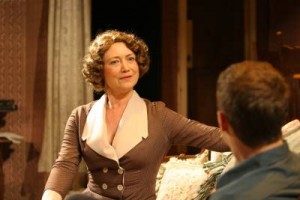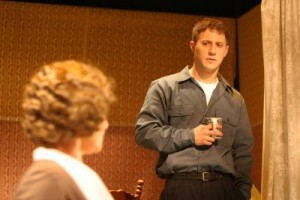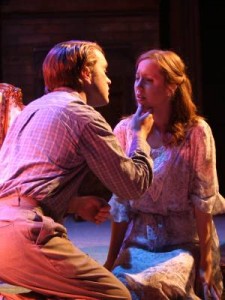
Sixty-some years after its Broadway premiere, Tennessee Williams’ The Glass Menagerie remains his most timeless work. With a production as fine as the one currently playing at Actors Co-op, it is hard to imagine a better or more rewarding evening of theater.
Director Brian Kite, whose Driving Miss Daisy and Proof for McCoy/Rigby productions have demonstrated his considerable talents, stages the Williams classic with profound respect for the original, at the same time keeping Williams’ most beloved and performed play fresh and vibrant. A superb cast combined with a first rate design team adds up to theatrical magic.
For those not acquainted with the play, The Glass Menagerie takes place in the memory of its narrator Tom Wingfield, a young man who, like his father before him, deserted a stifling family life for one of adventure. We never learn whether Tom’s father (“a telephone man who fell in love with long distances”) looked back with regret at the life and family he abandoned. Williams’ play makes it clear that Tom’s decision to abandon his mother Amanda and more especially his sister Laura still weighs heavy on his conscience, even years later.
Still, what other decision could a young man like Tom make, when every day began with the irritating screech of “Rise and shine” from his faded Southern belle of a mother, followed by a boring factory job which slowly but surely was killing his spirit. There are veiled hints in the script that Tom may have been gay, as Williams was. Whatever his reasons for leaving, he could never forget Laura, and The Glass Menagerie revolves around a pivotal incident in his sister’s life, the evening she received her first, and quite possibly her last “gentleman caller.”
Gentleman callers were hardly lacking in Amanda Wingfield’s debutante years. She once had seventeen of them on a single evening, something which she does not let either Tom or Laura forget.
Tom, at least, has the escape which even a drudgery-filled job provides. Painfully shy Laura has no such out, feeling stigmatized by a limp and so terrified of the outside world that she has been unable to complete even a week of the typing class Amanda has enrolled her in, choosing rather to spend her days taking solitary walks in the wintry cold. Only her “menagerie” of tiny glass animals seems to give her a reason to live, that is until Tom invites a former classmate of Laura’s to dinner.
From the moment the lights go up on an exquisitely lit tableau of narrator Tom, backed by Amanda and Laura, it becomes clear that Kite’s direction of The Glass Menagerie will be something to remember, a presumption borne out by what is to follow. Kite brings out all the poignancy in Williams’ script, but he also realizes that with a character like Amanda (character in both senses of the word), there will be laughter as well.
In the role of Tom, Co-op member Toby Meuli, who did memorable work in the Co- op Too production of A Hatful Of Rain, proves himself an actor of depth and power. Late in the play, Tom cries out, “I know I seem dreamy, but inside well, I’m boiling!” It is a testament to how totally Meuli has become the character that Williams created that one of the first notes I took about his performance was that there was “something boiling under the surface.” Meuli’s Tom hides depths of passion and anger that he is unable to express. The actor affects the speech pattern of someone of high social status, something which fits perfectly with Tom’s image of himself as a poet (nicknamed Shakespeare) trapped in the most prosaic of worlds. Meuli may well be a character actor trapped in the body of a leading man. The role of Tom allows him to be both.
Many character actresses have played Amanda over the years (Maureen Stapleton starred in two separate Broadway revivals), but if we are to believe that Amanda was indeed courted by dozens of gentlemen callers, then the part really ought to belong to a leading lady. Kite understands this, and has cast the lovely Lori Berg in the role, someone we can believe was the proverbial belle of the ball. Berg disappears into Amanda’s skin in a bravura performance which captures the faded debutante’s theatricality, pluck, and heart. It is a joy to hear Berg tell of those seventeen gentlemen callers with an enthusiasm which makes it seem as if Amanda were telling the tale for the first, rather than the umpteenth time. When Tom finally explodes, Berg makes us feel how truly stung Amanda is by his angry words.
Tawny Mertes, as Laura, is not the plain Jane actress that often gets cast as Laura, nor should she be. Laura’s insecurities have nothing to do with her looks, only with her perception of herself. When Jim, the gentleman caller, kisses her, it is because she is indeed a pretty girl. Mertes brings out all of Laura’s delicacy. Unlike Tom, Mertes’ Laura seems to live vicariously through her mother’s memories, and her face lights up whenever Amanda recalls her gentlemen callers of years past. Ideally, the actress playing Laura could have the role of Amanda in her future. Mertes is such an actress.
As Jim, Stephen Van Dorn gives his finest and most subtle performance since his award-nominated work in the Co-op’s production of The Hasty Heart. The actor looks and sounds as if he had just walked out of a 1930s movie, and he gives Jim a great character laugh. Van Dorn’s Jim is clearly a young man on the rise, and someone who knows how to put people at their ease, and his lengthy scene with Laura is played with charm, sensitivity, and sincerity.
Director Kite has worked closely with lighting designer Craig Pierce to make this Glass Menagerie the “memory play” which Williams intended it to be. A large oval black and white photograph of Tom’s father lights up when one of the characters speaks of him, as do the glass figures in Laura’s menagerie whenever she is cleaning or contemplating them. The famous telephone scene (“Ida Scott, You’re a Christian martyr, yes, that’s what you are, a Christian martyr!”) begins with a dimly lit Amanda, the lighting then becoming a mixture of pink and amber and violet as Tom wanders the stage observing her and the menagerie. In another scene, Tom steps out of an argument Amanda is having with him, and as she continues to rail against him, he wanders the apartment of his memories before resuming his position opposite her. Pierce’s lighting is particularly effective in the Jim/Laura scene, played in actual candlelight, but enhanced subtly by Pierce’s design.
Scenic designer John Iacovelli has contributed yet another fine set, a slightly run- down living room, with a dining area hidden behind lace curtains. The actual brick walls of the Crossley Terrace Theater and its ceiling plumbing can be seen above and behind the set, enhancing the urban effect. Jason Duplissea’s sound design mixes the old 78s on the Wingfield’s Victrola and the dance music coming dreamily from the nearby ballroom. Kara McLeod’s costumes accurately capture the period, and the spangled pink frock which Amanda has found deep in her closet is a particular delight, especially with the debutante tiara atop her Marcelled hair.
Whether you are seeing The Glass Menagerie for the umpteenth time or discovering it for the first (as were my theater guests), this is a treasure of a play (and production), as exquisitely beautiful as the glass figures of Laura’s menagerie.
Crossley Terrace Theatre, 1760 N. Gower Street, Hollywood.
–Steven Stanley
May 16, 2008





 Since 2007, Steven Stanley's StageSceneLA.com has spotlighted the best in Southern California theater via reviews, interviews, and its annual StageSceneLA Scenies.
Since 2007, Steven Stanley's StageSceneLA.com has spotlighted the best in Southern California theater via reviews, interviews, and its annual StageSceneLA Scenies.







 COPYRIGHT 2024 STEVEN STANLEY :: DESIGN BY
COPYRIGHT 2024 STEVEN STANLEY :: DESIGN BY